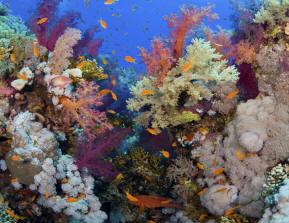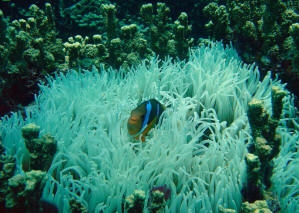Habitat
Like many other members of the genus
Amphirprion, the
species of Amphirprion
perideraion live in the habitat of a coral reef. Coral reefs
are known to be one of the most diverse habitats biologocally and are very
productive in the way that they work (Szczebak et al. 2013).
An area of large
diversity of the clownfish is nicknamed the “coral triangle,”
which is an area of overlapping Pacific and Indian Oceans (Timm
et al. 2008). There are many different ocean regions that this
organism can be found in because there are coral reefs in many
different areas around the world. The problem with these fish
residing in this habitat is that the coral reefs are very
susceptible to damages caused by the environment (Columbia
Electronic Encyclopedia 2013). For example the warming temperature, pollution of
the water near shore, and run off from companies can all cause
coral bleaching (Columbia
Electronic Encyclopedia 2013).
the warming temperature, pollution of
the water near shore, and run off from companies can all cause
coral bleaching (Columbia
Electronic Encyclopedia 2013).
Like other species of anemone fish,
Amphirprion perideraion,
reside in another organism that has developed a mutualistic
relationship with the fish. For more information on this relationship see the
Interactions page.
The organism involved is a
sea anemone. It has been found that for
the abundant variety of species of clownfish, there are only about
10 species of anemones in which they reside (Drury 2008).
One of the aspects of
the interaction between this organism and the anemone is that the
 anemone
fish will actually help the anemone to receive oxygen and other
nutrients. The anemone is sessile, sp it relies on the clownfish
to go out and do its part in the mutualistic relationship (Szczebak
et al. 2013).
anemone
fish will actually help the anemone to receive oxygen and other
nutrients. The anemone is sessile, sp it relies on the clownfish
to go out and do its part in the mutualistic relationship (Szczebak
et al. 2013).
Pink Skunk Clownfish are known to be poor
swimmers so in turn the fish does not leave the sea anemone very
often. Due to its mutualistic relationship the fish does not have to
leave for food and is completely protected from predators. However,
during Reproduction,
the female and male have to leave to the underside of the anemone to
lay and protect the eggs (Drury 2008).
Along with the other clownfish species, they
have a very good relationship with the organism that they call home.
The place they call home is located in a very large diverse area of
organisms called a coral reef. There are many other organisms that
can be found in this same habitat ranging from small sizes to large
sizes. The magnificent organisms that call the magical world of a
coral reef home also face some dangers. Many common issues that are
known involve the death of the organisms that make up the coral
reef. What happens to the mobile organism that is dependent on the
coral reefs, if the reefs continue to die?
Back to Home Continue to Adaptations
